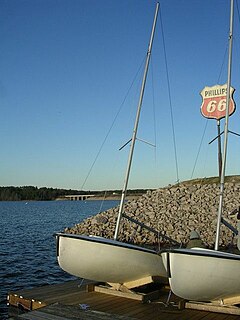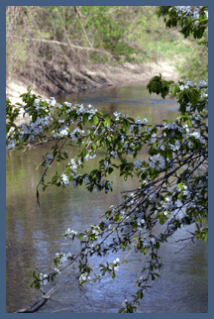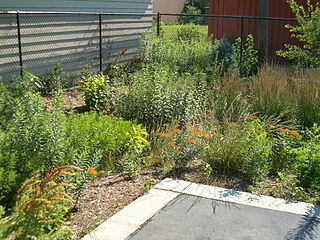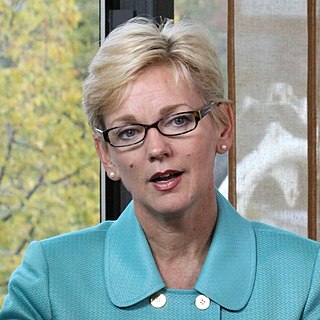
Lake Michigan is one of the five Great Lakes of North America and the only one located entirely within the United States. The other four Great Lakes are shared by the U.S. and Canada. It is the second-largest of the Great Lakes by volume and the third-largest by surface area, after Lake Superior and Lake Huron. To the east, its basin is conjoined with that of Lake Huron through the wide Straits of Mackinac, giving it the same surface elevation as its easterly counterpart; the two are technically a single lake.

Scouting in Michigan has a long history, from the 1910s to the present day, serving thousands of youth in programs that suit the environment in which they live.

The United States Public Health Service (USPHS) is a division of the Department of Health and Human Services concerned with public health. It contains eight out of the department's eleven operating divisions. The Assistant Secretary for Health (ASH) oversees the PHS. The Public Health Service Commissioned Corps (PHSCC) is the federal uniformed service of the USPHS, and is one of the seven uniformed services of the United States.

Water quality refers to the chemical, physical, biological, and radiological characteristics of water. It is a measure of the condition of water relative to the requirements of one or more biotic species and or to any human need or purpose. It is most frequently used by reference to a set of standards against which compliance, generally achieved through treatment of the water, can be assessed. The most common standards used to assess water quality relate to health of ecosystems, safety of human contact, and drinking water.

Lake St. Clair is a freshwater lake that lies between the Canadian province of Ontario and the U.S. state of Michigan. It was named after Clare of Assisi, on whose feast day it was navigated and christened by French Catholic explorers in 1679. It is part of the Great Lakes system, and along with the St. Clair River and Detroit River, Lake St. Clair connects Lake Huron with Lake Erie. It has a total surface area of about 430 square miles (1,100 km2) and an average depth of just 11 feet (3.4 m); to ensure an uninterrupted waterway, government agencies in both countries have maintained a deep shipping channel through the shallow lake for more than a century.

B. Everett Jordan Lake is a reservoir in New Hope Valley, west of Cary and south of Durham in Chatham County, North Carolina, in the United States; the northernmost end of the lake extends into southwestern Durham County.

The Clean Water Act (CWA) is the primary federal law in the United States governing water pollution. Its objective is to restore and maintain the chemical, physical, and biological integrity of the nation's waters; recognizing the responsibilities of the states in addressing pollution and providing assistance to states to do so, including funding for publicly owned treatment works for the improvement of wastewater treatment; and maintaining the integrity of wetlands. It is one of the United States' first and most influential modern environmental laws. As with many other major U.S. federal environmental statutes, it is administered by the U.S. Environmental Protection Agency (EPA), in coordination with state governments. Its implementing regulations are codified at 40 C.F.R. Subchapters D, N, and O.

The Anacostia River is a river in the Mid Atlantic region of the United States. It flows from Prince George's County in Maryland into Washington, D.C., where it joins with the Washington Channel to empty into the Potomac River at Buzzard Point. It is approximately 8.7 miles (14.0 km) long. The name "Anacostia" derives from the area's early history as Nacotchtank, a settlement of Necostan or Anacostan Native Americans on the banks of the Anacostia River.

The Ottawa River, also known as Ottawa Creek, is a short river, approximately 20 miles (32 km) long, in northwest Ohio and southeast Michigan in the United States. It drains an area on the Ohio-Michigan border along the eastern and northern fringes of the city of Toledo, goes through Ottawa Hills, and empties directly into Lake Erie. It is one of two rivers in northwestern Ohio that share the same name, along with the Ottawa River that is a tributary of the Auglaize River. The upper 4 miles (6 km) of the river in Michigan north of Sylvania, Ohio is called North Tenmile Creek on federal maps, while another branch rising in Fulton County, Ohio, is called Tenmile Creek.

One of the wide variety of soil-absorption/filter systems, a rain garden, also called a stormwater garden, is a designed depression storage or a planted hole that allows rainwater runoff from impervious urban areas, like roofs, driveways, walkways, parking lots, and compacted lawn areas, the opportunity to be absorbed. The primary purpose of a rain garden is to improve water quality in nearby bodies of water and to ensure that rainwater becomes available for plants as groundwater rather than being sent through stormwater drains straight out to sea. In fact, it can actually reduce rain runoff by allowing stormwater to soak into the ground and cut down on the amount of pollution reaching creeks and streams by up to 30%.
The Michigan Department of Environment, Great Lakes, and Energy (EGLE), formerly Michigan Department of Environmental Quality, is a principal department of the U.S. state of Michigan for environmental issues. The department was created in 1995.
Environmental quality is a set of properties and characteristics of the environment, either generalized or local, as they impinge on human beings and other organisms. It is a measure of the condition of an environment relative to the requirements of one or more species, any human need or purpose.
Clean Water Services is the water resources management utility for more than 600,000 residents in urban Washington County, Oregon and small portions of Multnomah County, Oregon and Clackamas County, Oregon, in the United States. Clean Water Services operates four wastewater treatment facilities, constructs and maintains flood management and water quality projects, and manages flow into the Tualatin River to improve water quality and protect fish habitat. They are headquartered in Hillsboro.
Leila (Lee) Botts is a prominent American environmentalist known primarily for her work related to conservation and restoration of the Great Lakes. She has founded two successful non-profit organizations, directed a subagency of the U.S. Department of the Interior in the administration of President Jimmy Carter, authored or co-authored a number of books and reports on environmental issues, and served in the administration of the late Chicago Mayor Harold Washington.
The Rivers and Harbors Act of 1965, Title III of Pub.L. 89–298, was enacted October 27, 1965, by the 89th United States Congress. The act authorized the U.S. Army Corps of Engineers to design and construct numerous navigation and beach erosion projects.

The Delaware River Basin Commission (DRBC) is a United States government agency created in 1961 by an interstate compact, signed into law by President John F. Kennedy, between four states.
United States v. Riverside Bayview, 474 U.S. 121 (1985), was a United States Supreme Court case challenging the scope of federal regulatory powers over waterways as pertaining to the definition of "waters of the United States" as written in the Clean Water Act of 1972. The Court ruled unanimously that the government does have the power to control intrastate wetlands as waters of the United States. This ruling was effectively revised in Rapanos v. United States (2006), in which the Court adopted a very narrow interpretation of "navigable waters."
Point source water pollution comes from discrete conveyances and alters the chemical, biological, and physical characteristics of water. In the United States, it is largely regulated by the Clean Water Act (CWA). Among other things, the Act requires dischargers to obtain a National Pollutant Discharge Elimination System (NPDES) permit to legally discharge pollutants into a water body. However, point source pollution remains an issue in some water bodies, due to some limitations of the Act. Consequently, other regulatory approaches have emerged, such as water quality trading and voluntary community-level efforts.












